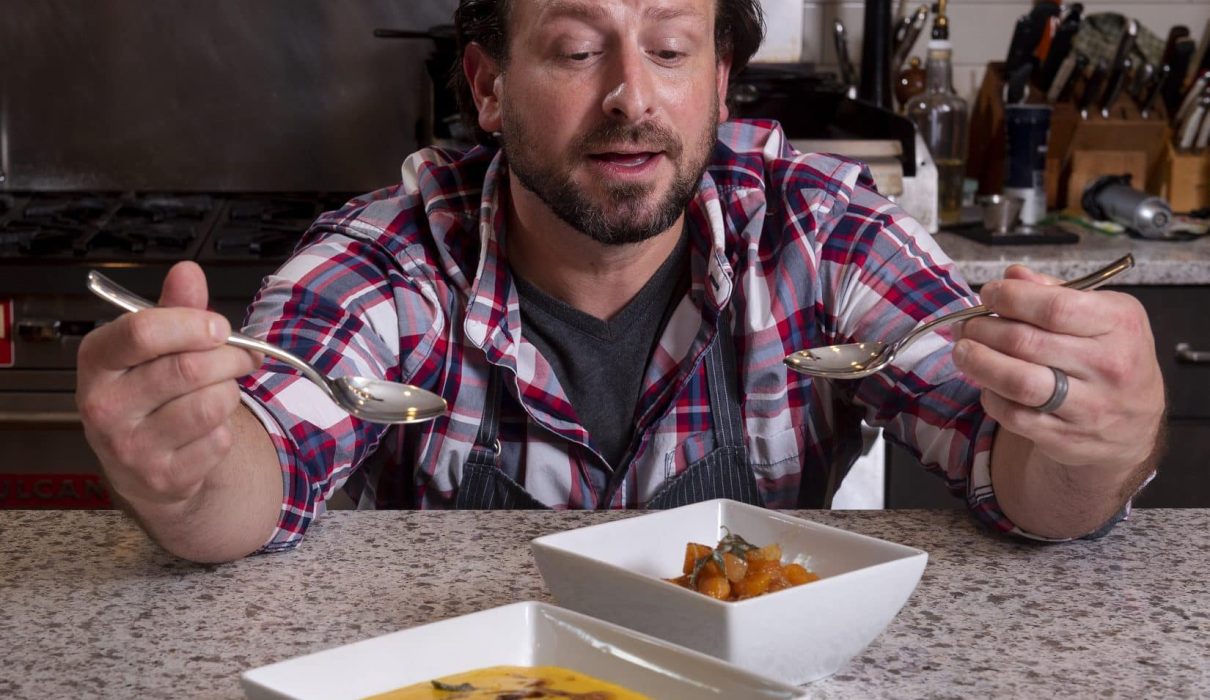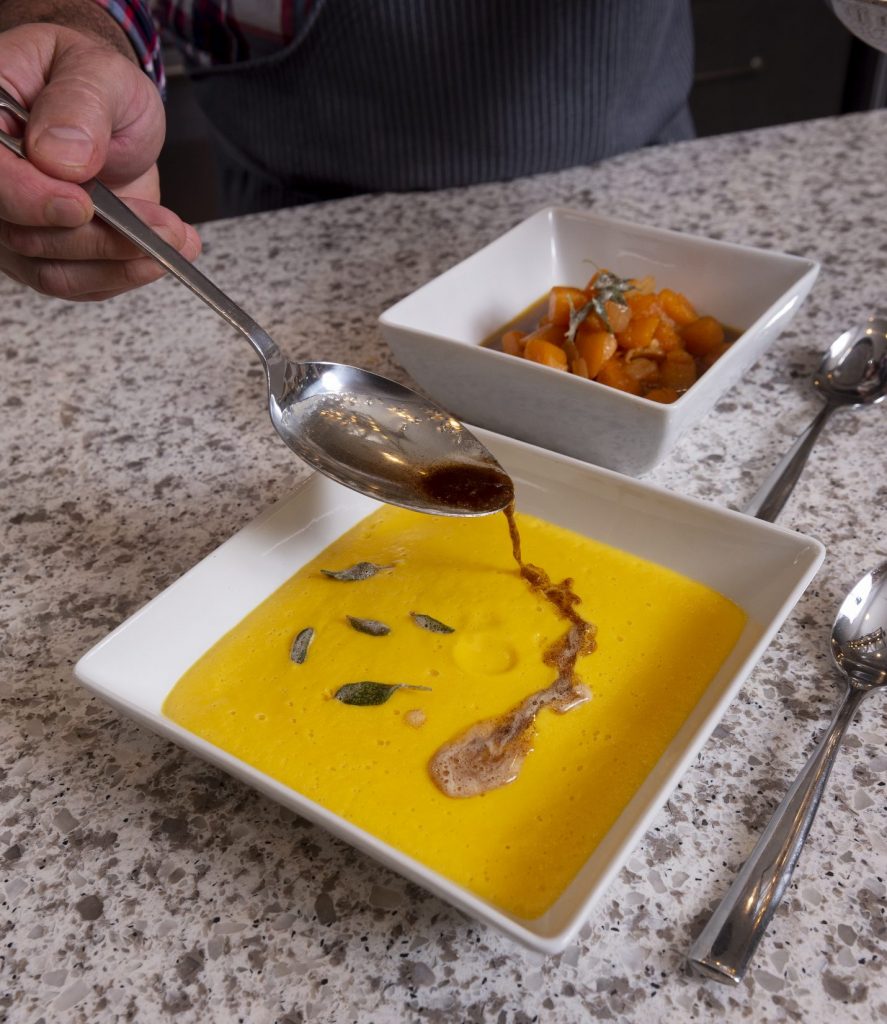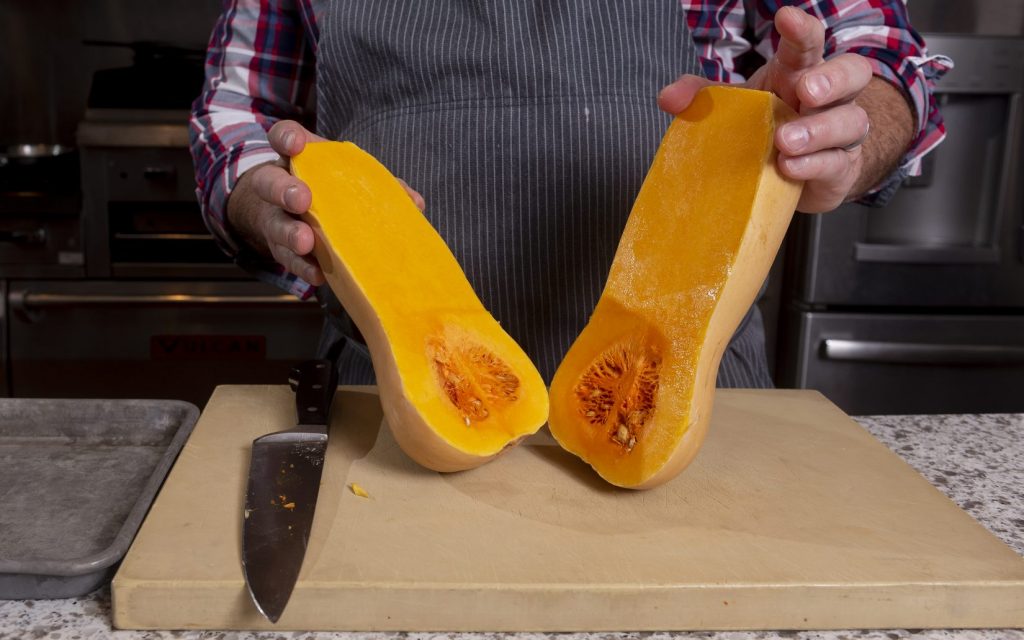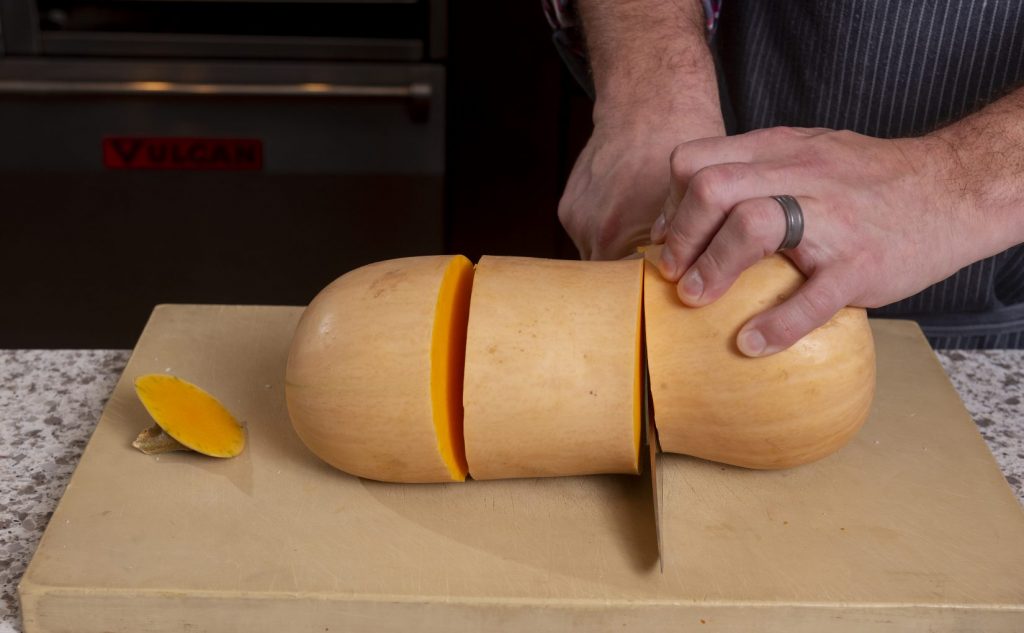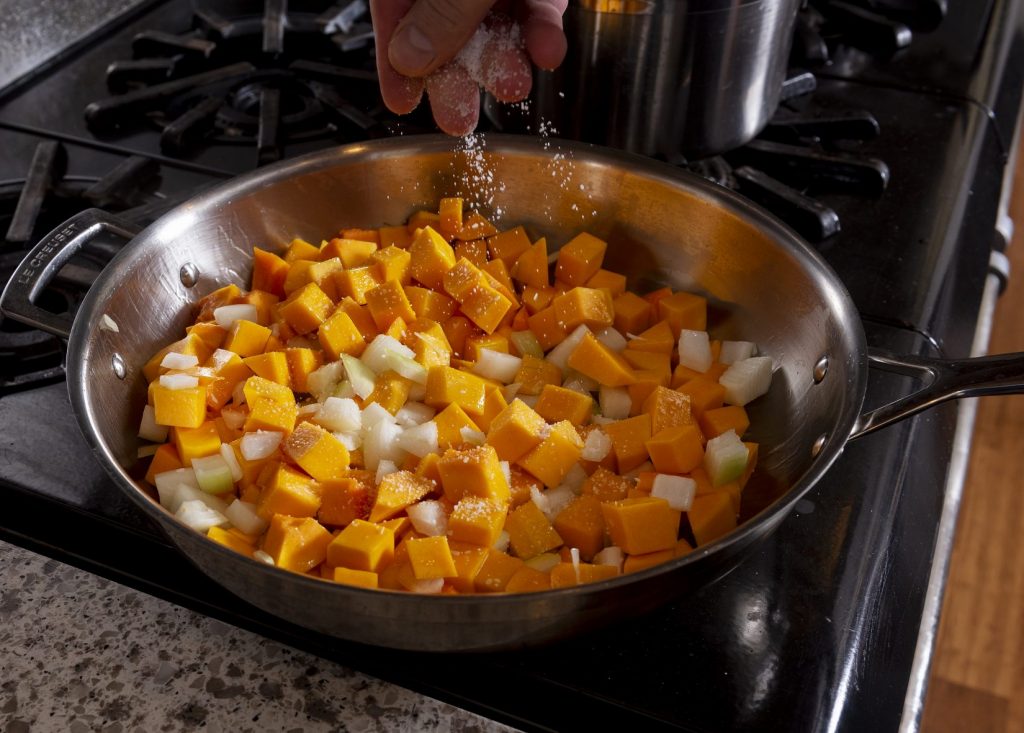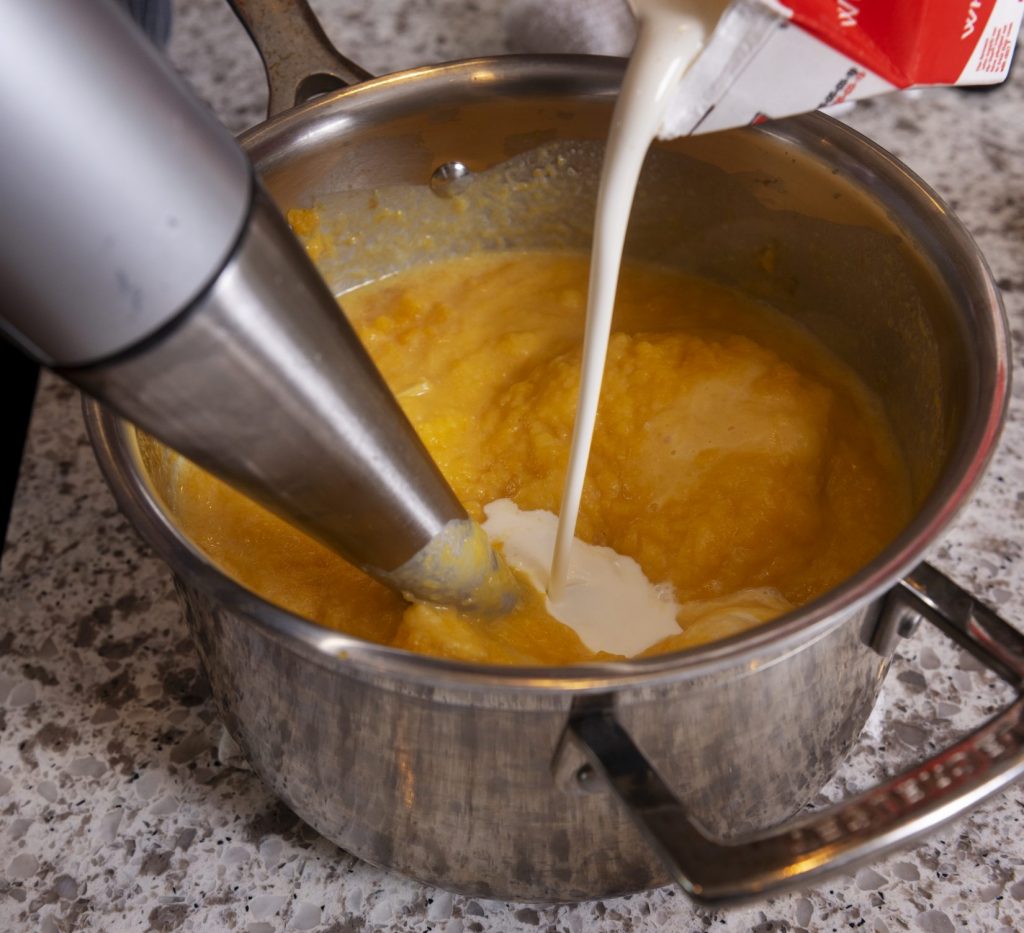It was the best of soups, it was the worst of — well actually, both soups are really good. You can take almost the same ingredients, change the method a bit, and have two distinctly different soups. This recipe is written for butternut squash but could be made with pumpkin, acorn squash, sweet potato, French turban, spaghetti squash, or any other type of root vegetable or winter squash.
Cut
We call them winter squash, but they are harvested in the fall. The thick skins allow them to be stored throughout the fall into the winter. You may even still have some leftover from your fall decorations on your front porch (I know I do). The thick skins aid in storage, but also cause a little timidness in some people. If you plan to roast the squash (best for a smooth soup), you can cut the stem off, split the top half, then reverse the cut to cut through the base and the seeds. Use a spoon to scoop out the seeds and you are ready to roast.
If you plan to dice the squash for a chunky soup, it’s just a few more steps. Instead of cutting the squash lengthwise, cut the stem of the squash off, then cut into 3 or 4 sections horizontally. Stand each section upright and cut a small section down of the peel at a time, rotating until the peel is removed. Then cut into ½ sections, then ½ strips and then into ½-inch cubes.
Cook
Roasting is an easy part of the smooth soup. The squash gets cut, scooped and slathered with oil and salt, then placed cut-side down onto an oven-safe vessel to cook. This allows you a little extra time to gather and cut other ingredients. Be sure to start the roasting first. You can add the onion about halfway through, then finish with the garlic and ginger. Color should develop on all the ingredients and by the end, the squash should easily pierce with a paring knife.
As for the chunky soup, the onion and the squash can get diced then sauteed together. You want to do this at pretty high heat. You’re not trying to cook the squash during this step —mostly just develop color and flavor — the squash can cook with the stock later. Once the color has started to develop you can add in the garlic and ginger. After a few minutes, you can add the stock and maple syrup and cook until the squash become tender. If you’re not planning to eat the soup that day, it may be best to undercook the squash and cook it fully when you reheat it.
Blend
No need to blend the chunky soup, but for the smooth one I prefer a hand blender. This allows you to blend as soon as the milk comes to a simmer (soup will puree much easier when hot). You can then cook a little longer if it’s not as smooth as you desire — any slight chunkiness means that some of the vegetables need to cook a little longer. You can transfer the hot soup to an upright blender. It’s safer when blending hot items to place a towel over the top in addition to the lid.
1 butternut squash (3 to 4 pounds)
1 onion
2 to 3 ounces olive oil or other fat
3 to 4 cloves of garlic
1 tablespoon ginger
1 pint of milk for smooth or stock for chunky (more as needed)
2 to 3 ounces maple syrup
4 to 5 ounces of cream (optional for smooth)
Salt and pepper to taste
Method 1 – Smooth soup
Cut the butternut squash in half lengthwise and scoop out the seeds. Oil the cut side and season heavily with salt. Place cut-side down on a sheet tray, casserole dish or pan. Bake at 400 degrees for 25 minutes in a convection oven (450 degrees in a conventional oven, no fan). While squash is baking, prep other ingredients. Cut the top and bottom off an onion then cut in half, oil and salt heavily and reserve the first 25 minutes while the squash is baking. Peel garlic cloves and cut off the root ends, peel ginger by scraping with a spoon and slice thinly. Once the squash has baked 25 minutes, add the oiled and seasoned onion to the pan with the squash and bake 15 minutes, add garlic and ginger and bake another 10 minutes. All of the items should be starting to develop some color and the squash and onion should pierce easily with a knife. Remove from the oven and allow to cool for 10 to 15 minutes, flipping the squash cut side up to cool faster. Remove the peel of the onion, cut into smaller chunks, and put it into a 3 to a 4-quart saucepan along with the garlic and ginger. Use a spoon to scoop out the inside of the butternut squash and add to the saucepan. Be careful not to add any of the skin from the squash. Add in the milk, maple syrup and cream, if desired. Bring to a simmer over low heat and puree with a hand blender. You may also transfer to an upright blender to puree. Adjust the thickness with more milk if desired. Adjust the seasoning with salt and pepper and serve with brown butter and sage.
Method 2 – Chunky soup
Cut the squash and onion into ½-inch cubes. Over medium-high heat, sauté in a large sauté pan with oil or split between two pans until color develops on the edges of the onion and squash. Mince the garlic and ginger and add to the squash and onion. Cook until the garlic and ginger become fragrant, about 2 to 3 minutes. If cooking between two pans, combine and add the stock (preferably darker chicken, beef or pork stock, but water or vegetable stock would also work) and maple syrup. Cook over low heat until squash just starts to become tender. If you go too far with it, it will fall apart. Adjust the seasoning with salt and pepper and serve with brown butter and sage.
Brown butter with sage to finish
3 to 4 tablespoons unsalted butter
3 to 5 small sage leaves per bowl
Salt as needed
Once the soup is completed and portioned into warm bowls, add butter to a small sauté pan over medium heat. Add a small pinch of salt (don’t add salt if using salted butter). Cook while swirling occasionally until the edges just barely start to become brown. Add in sage leaves and keep swirling. Sage leaves will start to bubble and the rest of the butter with brown. Before butter becomes too dark, remove from the heat and spoon a small amount of butter and sage leaves in the center of each soup.

